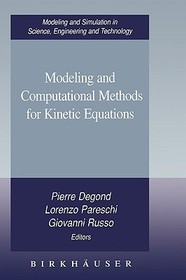
Modeling and Computational Methods for Kinetic Equations
Series: Modeling and Simulation in Science, Engineering and Technology;
- Publisher's listprice EUR 106.99
-
44 374 Ft (42 261 Ft + 5% VAT)
The price is estimated because at the time of ordering we do not know what conversion rates will apply to HUF / product currency when the book arrives. In case HUF is weaker, the price increases slightly, in case HUF is stronger, the price goes lower slightly.
- Discount 12% (cc. 5 325 Ft off)
- Discounted price 39 049 Ft (37 190 Ft + 5% VAT)
Subcribe now and take benefit of a favourable price.
Subscribe
44 374 Ft

Availability
Estimated delivery time: In stock at the publisher, but not at Prospero's office. Delivery time approx. 3-5 weeks.
Not in stock at Prospero.
Why don't you give exact delivery time?
Delivery time is estimated on our previous experiences. We give estimations only, because we order from outside Hungary, and the delivery time mainly depends on how quickly the publisher supplies the book. Faster or slower deliveries both happen, but we do our best to supply as quickly as possible.
Product details:
- Edition number 2004
- Publisher Birkhäuser Boston
- Date of Publication 7 April 2004
- Number of Volumes 1 pieces, Book
- ISBN 9780817632540
- Binding Hardback
- See also 9781461264873
- No. of pages356 pages
- Size 235x155 mm
- Weight 1540 g
- Language English
- Illustrations XI, 356 p. Illustrations, black & white 0
Categories
Long description:
"
In recent years kinetic theory has developed in many areas of the physical sciences and engineering, and has extended the borders of its traditional fields of application. New applications in traffic flow engineering, granular media modeling, and polymer and phase transition physics have resulted in new numerical algorithms which depart from traditional stochastic Monte--Carlo methods.
This monograph is a self-contained presentation of such recently developed aspects of kinetic theory, as well as a comprehensive account of the fundamentals of the theory. Emphasizing modeling techniques and numerical methods, the book provides a unified treatment of kinetic equations not found in more focused theoretical or applied works.
The book is divided into two parts. Part I is devoted to the most fundamental kinetic model: the Boltzmann equation of rarefied gas dynamics. Additionally, widely used numerical methods for the discretization of the Boltzmann equation are reviewed: the Monte--Carlo method, spectral methods, and finite-difference methods. Part II considers specific applications: plasma kinetic modeling using the Landau--Fokker--Planck equations, traffic flow modeling, granular media modeling, quantum kinetic modeling, and coagulation-fragmentation problems.
""Modeling and Computational Methods of Kinetic Equations"" will be accessible to readers working in different communities where kinetic theory is important: graduate students, researchers and practitioners in mathematical physics, applied mathematics, and various branches of engineering. The work may be used for self-study, as a reference text, or in graduate-level courses in kinetic theory and its applications.
In recent years kinetic theory has developed in many areas of the physical sciences and engineering, and has extended the borders of its traditional fields of application. This monograph is a self-contained presentation of such recently developed aspects of kinetic theory, as well as a comprehensive account of the fundamentals of the theory. Emphasizing modeling techniques and numerical methods, the book provides a unified treatment of kinetic equations not found in more focused works.
Specific applications presented include plasma kinetic models, traffic flow models, granular media models, and coagulation-fragmentation problems. The work may be used for self-study, as a reference text, or in graduate-level courses in kinetic theory and its applications.
" MoreTable of Contents:
I. Geometric Operators and the Inde.- Spectral invariants of operators of Dirac type on partitioned manifolds.- Index theory of Dirac operators on manifolds with corners up to codimension two.- Index defects in the theory of spectral boundary value problems.- Cyclic homology and pseudo differential operators, a survey.- Index and secondary index theory for flat bundles with duality.- II. Elliptic Boundary Value Problems.- Toeplitz operators, and ellipticity of boundary value problems with global projection conditions.- On the tangential oblique derivative problem — methods, results, open problems.- A note on boundary value problems on manifolds with cylindrical ends.- Relative elliptic theory.- Appendix. Fourier Integral Operators.- A.1. Homogeneous Lagrangian manifolds.- A.2. Local description of homogeneous Lagrangian manifolds.- A.3. Composition of homogeneous Lagrangian manifolds.- A.4. Definition of Fourier integral operators.- A.5. Pseudodifferential operators as Fourier integral operators.- A.6. Boundedness theorems.- A.7. Composition theorems.- References.
More



